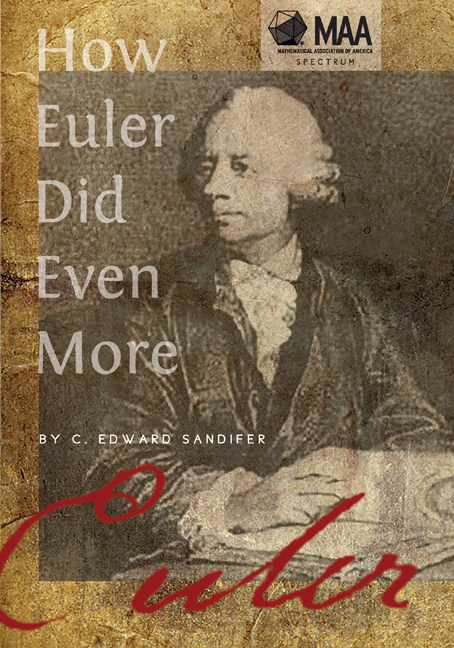Book contents
- Frontmatter
- Contents
- Preface
- Part I Geometry
- Part II Number Theory
- Part III Combinatorics
- Part IV Analysis
- Part V Applied Mathematics
- 26 Density of Air (July 2009)
- 27 Bending Light (August 2009)
- 28 Saws and Modeling (November 2008)
- 29 PDEs of Fluids (September 2008)
- 30 Euler and Gravity (December 2009—A Guest Column by Dominic Klyve)
- Part VI Euleriana
- About the Author
28 - Saws and Modeling (November 2008)
from Part V - Applied Mathematics
- Frontmatter
- Contents
- Preface
- Part I Geometry
- Part II Number Theory
- Part III Combinatorics
- Part IV Analysis
- Part V Applied Mathematics
- 26 Density of Air (July 2009)
- 27 Bending Light (August 2009)
- 28 Saws and Modeling (November 2008)
- 29 PDEs of Fluids (September 2008)
- 30 Euler and Gravity (December 2009—A Guest Column by Dominic Klyve)
- Part VI Euleriana
- About the Author
Summary
Euler seemed to be interested in everything, and when he was interested in something, he sought to understand it with mathematics. Somehow, he got interested in saws, and in 1756, while working at the Berlin Academy, he wrote a 25-page paper, Sur l'action des scies, “On the action of saws” [E235].
I can only speculate on why Euler decided to write this paper. In their Editors' Introduction to the volume of the Opera omnia where this paper is reprinted, Charles Blanc and Pierre de Haller suggest that “its main purpose was to show one more time the possibility of putting into play the laws of mechanics and the techniques of mathematical analysis for measuring out the best advantage for concrete situations. One does not find in fact any truly new idea about the use of mathematics in practice.”
I would suggest a more practical and timely motivation. When Euler first arrived in St. Petersburg in 1728, his actual position was as Physician to the Russian Navy. He mostly worked at the St. Petersburg Academy, but the Navy had some claim on his time and efforts. Reportedly, as part of a tour of military facilities, Euler visited some of the sawmills that provided lumber to the Navy. There he learned both the critical importance of lumber to military operations and the actual operation of sawmills.
Almost 30 years later, Euler was working in the academy of the Prussian King Frederick II, who was about to embark on what is often called the Seven Years War, except in America where we learn of it as the French and Indian War. It would also make sense if Euler, remembering the strategic importance of lumber supplies, were trying to help his King in the forthcoming war effort.
Regardless of his motivations, Euler begins his analysis of saws by describing the scope of his problem. First, he is interested in vertical saws being moved by a machine in a steady, repeatable way, not in horizontal saws or saws that are being moved by the hands of real people. He has two reasons for this restriction.
- Type
- Chapter
- Information
- How Euler Did Even More , pp. 186 - 191Publisher: Mathematical Association of AmericaPrint publication year: 2014



